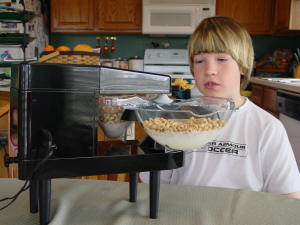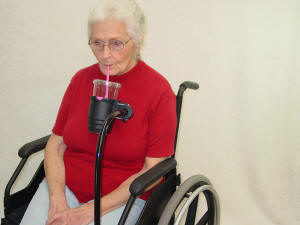October 2020 Independent Eating and Drinking Newsletter
| Independent Eating and Drinking are Wonderful |
 |
| October Newsletter Topics: |
|
| Subscribe to Newsletters |
Overlooked Factors When Choosing Dining Equipment
When people decide that they would like to buy something new many things contribute to how they make the decision about what to buy. Many of the reasons are based on their requirements but, additionally, there are always some emotions involved. How something looks is one of the big influencers. However, when selecting equipment that facilitates independent eating, very often the options of what will work is limited by the functional capacity of the person who is going to use it, and not the appearance of the specific equipment that works for them.
In last month’s newsletter we discussed the progression of feeding equipment development over the past several decades. Included in the article was information about why people, who are unable to feed themselves, could not use the equipment that was available in 2000 (to draw your attention to the reasons being discussed they are identified in bold italics throughout the article).Some very significant reasons were identified and it may be helpful to examine some of those reasons in a little more detail and see how they apply to today’s equipment.
A critical part of becoming independent at mealtimes, is access to equipment. A decade ago it was estimated that more than half of the people who were unable to feed themselves were not able to access equipment that sat on a table top to be used. For many people who use powered wheelchairs, equipment that is placed on a tabletop for use is impossible for them to access. They cannot get close enough to the table for a number of reasons: the arms of the chair limit how close they can pull up to the table; various other parts of the wheelchair also limit how close the wheelchair can be pulled up to the table without significant reconfiguration of the wheelchair at mealtimes; the height of the wheelchair does not allow some individuals knees to fit under the table; etc. Also, for people who have skeletal anomalies it is not always easy to reach equipment placed on a table. Finally, those who do not have good trunk control are not always stable enough to move their mouths forward and backward to comfortably access equipment that is placed on a table for use.
Lack of a method to control the volume of food on the spoon meant that the amount of food served bite by bite was totally unpredictable. Big clumps of food might be served for one bite and the next could be an empty spoon. For people who needed a reliably, small amount of food for each bite, to avoid choking or aspiration, this issue made independent eating with a device that did not control the amount of food on the spoon, dangerous.
Other issues raised as problems have been addressed in various ways by different manufactures and include: difficult to use, unreliable, inconvenient, difficult to transport, and too time consuming to set up.
Feeding devices are not cheap, even the least expensive powered device on the market is priced in the several thousands of dollars range. Because they are so expensive it is rare that people are able to fund a feeding device out of their own pocket. More commonly they seek funding from their health insurance provider or other sources. However, if funding cannot be found the person typically is unable to acquire a dining system. If you need help with funding please call Mealtime Partners staff, they will be happy to assist you! They can be reached by email at: info@mealtimepartners.com or by phone at 800-996-8607 or 817-237-9991.
|
Whether it is eating or drinking Mealtime Partners has a HANDS-FREE solution to independence |
|
 |
 |
| The Mealtime Partner Dining System on Legs | The Front Mounted Drinking System |
Independent eating, whether it is accomplished in the traditional way, using your hands, or using assistive technology, allows you to select the order in which the various foods that are being served are eaten, and also the pace at which each bite is eaten. Thus, meats can be chewed for however long it takes to break the bite into particles that are easy to swallow, while the soft food, like pudding, can be swallowed quite rapidly. The Mealtime Partner Dining System allows those individuals who cannot feed themselves using their hands and a utensil, to be able to control their mealtime completely. They can change the pace of eating to accommodate the textures of food that are being eaten, and also to pause to interact with other diners. Additionally, plenty of water should be consumed, all day long. For those individuals who are unable to pick up a cup, maintaining healthful consumption of liquids can be difficult. Mealtime Partners products provide a solution. For more information about our drinking products, please visit the Drinking page on the Mealtime Partners website. |
|
| For more information about the most flexible assistive dining system available, please visit: The Mealtime Partner Dining Device Description webpage, or call us at 800-996-8607. | |
Veterans and ALS
Unfortunately, not only do our veterans serve our country placing them at risk, they face another risk later in their lives that is just as deadly as war can be: Amyotrophic Lateral Sclerosis (ALS). Studies have shown that veterans have a far greater risk of developing ALS than their non-military counterparts, regardless of the branch of the military in which they served, or whether they served during war time or peace time. The cause is as yet unknown, but veterans as a whole are twice as likely to develop ALS as those who have never served in the military .
Several studies have confirmed that the incidence of ALS is higher in veterans than any other group. Because of this finding the Department of Veterans Affairs (VA) in 2008 implemented a regulation establishing that ALS is service connected. The regulation recognizes that if ALS occurs in a veteran, the veteran and their family should receive benefits for a service connected illness and disability. In 2011, the VA amended the regulation to stipulate that any veteran diagnosed as having ALS will immediately receive a 100% disability rating.
The VA has established a national registry of cases of ALS in military veterans. Additionally, in 2008, Congress established the National ALS Registry at the Centers for Disease and Prevention (CDC). The registry provides data to researchers about the occurrence of ALS .
Veterans who are diagnosed with ALS can receive treatment from many of the VA Hospitals throughout the US. Several of these hospitals have ALS clinics that provide multi-disciplinary services to veterans with ALS. Additional information about ALS and the services that are available can be found through the ALS Associations website. Their website is an excellent source of information and provides resource information including clinics, chapters and support groups under the “Find Local Services” tab on their home page.
In many instances eating and drinking can become difficult for people with ALS. When self-feeding and drinking are no longer possible, the individual has two choices: to be fed by a caregiver, or to use assistive technology to continue to eat independently. Equipment like the Mealtime Partner Dining System can be very helpful over an extended time. It is advisable to acquire the equipment as soon as it is identified that hand function will decline. If the equipment is available early in the disease progression, the user has the opportunity to become familiar with it before it is essential; and, the equipment can also be used on days when the person is excessively tired, or for eating food that is difficult to pick up and eat with a hand-held utensil, like soup or pudding. Because the equipment can be configured in a wide range of modes, it can be adjusted to accommodate the changing needs of the user. It can be set to operate more slowly. It can use two adaptive switches for control, and then, when needed, be changed to work with a single switch, or fully automatically, with no switches. Additionally, the Mealtime Partner is able to serve a wide range of food textures varying from normal food that is simply cut into bite sized pieces to minced and pureed food.
Regardless of the difficulties that are experienced because of ALS, good hydration and nutrition are essential to maintain the best quality of life possible .
|
Did you know? Did you know that researchers at Arizona State University (ASU) and Caltech have been studying how the human microbiome impacts the human brain? Working at first separately and more recently in collaboration, the scientists looked at the gut bacteria in children with autism. Early trials transplanted fecal matter, harvested from healthy volunteers, into the cleansed guts of participating children who had severe autism. Two years after the process 44% of the children were no longer on the autism scale. Distinct changes were seen in their gut bacteria. To identify what, on a cellular level, was happening, further research was conducted. Fecal matter from severely autistic individuals was transplanted into germ-free mice. The off-spring of these mice showed autistic-like symptoms. Upon further examination into brain chemicals it was found that the mice showing autistic-like symptoms had reduced levels of specific brain chemicals and this reduction was also seen in humans with autism. Further research is being conducted and the researchers hope to provide help to not just people with autism but those with other diseases as well. Further information can be found at: https://www.discovermagazine.com/health/autisms-gut-connection-microbes-could-soon-lead-to-new-treatment. |
Click here to subscribe to the Mealtime Partners Newsletters
Please send comments and suggestions to newsletters@mealtimepartners.com
Copyright © Mealtime Partners, Inc. 2020
All rights reserved.
Mealtime Partners Website Navigation: